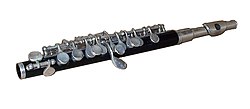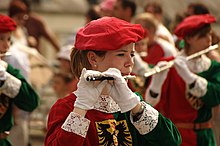Piccolo
 | |
| Woodwind instrument | |
|---|---|
| Classification | |
| Hornbostel–Sachs classification | 421.121.12-71 (Flute-like aerophone with keys) |
| Playing range | |
 The piccolo sounds one octave higher than written.  | |
| Related instruments | |
The piccolo /ˈpɪkəloʊ/ (Italian pronunciation: [ˈpikkolo]; Italian for "small")[1][2] is a half-size flute, and a member of the woodwind family of musical instruments. The modern piccolo has most of the same fingerings as its larger sibling, the standard transverse flute,[3] but the sound it produces is an octave higher than written. This has given rise to the name ottavino (Italian for "little octave"), by which the instrument is called in the scores of Italian composers.[4] It is also called flauto piccolo or flautino.

In the orchestral setting, the piccolo player is often designated as "piccolo/flute III", or even "assistant principal". The larger orchestras have designated this position as a solo position due to the demands of the literature. Piccolos are often orchestrated to double the violins or the flutes, adding sparkle and brilliance to the overall sound because of the aforementioned one-octave transposition upwards. In concert band settings, the piccolo is almost always used and a piccolo part is almost always available.
History[]
Since the Middle Ages we had evidence of the use of octave transverse flutes as military instruments: their penetrating sound was in fact audible above the roar of battle. In cultured music, however, the first piccolo are used in some works by Jean Philippe Rameau in the first half of the eighteenth century, but the instrument begins to spread, and therefore to have a stable place in the orchestra, only at the beginning of 800 A.D. During the Baroque period the indication "flautino" or also "flute piccolo" usually indicated a recorder of small size (soprano or sopranino), and in particular this is the case of the concerts that Antonio Vivaldi he wrote for flute.[5]
Until the end of the 19th century the piccolo maintained the same construction with more keys than the classical and romantic flute of the old system, and only at the end of the century it began to be built with the Boehm mechanism, which in any case would become the standard only during the 1900s.
In 2014, a festival was born entirely dedicated to piccolo,[6] the , which takes place annually in July in (GO).
Traditional use[]

Historically, the piccolo had no keys, but it should not be confused with the fife, which is traditionally one-piece, has a smaller, cylindrical bore and produces a more strident sound.
It is a myth that one of the earliest pieces to use the piccolo was Ludwig van Beethoven's Symphony No. 5 in C Minor, premiered in December 1808. Although neither Joseph Haydn nor Wolfgang Amadeus Mozart used it in their symphonies, some of their contemporaries did, including Franz Anton Hoffmeister, Franz Xaver Süssmayr, and Michael Haydn.[7] Also, Mozart used the piccolo in his opera Idomeneo. Opera orchestras in Paris sometimes included small transverse flutes at the octave as early as 1735 as existing scores by Jean-Philippe Rameau show.[7]
Piccolos are now mainly manufactured in the key of C. In the early 20th century, piccolos were manufactured in D♭ as they were an earlier model of the modern piccolo.[8] It was for this D♭ piccolo that John Philip Sousa wrote the famous solo in the final repeat of the closing section (trio) of his march "The Stars and Stripes Forever".
Although once made of wood, glass or ivory, piccolos today are made from plastic, resin, brass, nickel silver, silver, and a variety of hardwoods, most commonly grenadilla. Finely made piccolos are often available with a variety of options similar to the flute, such as the split-E mechanism. Most piccolos have a conical body with a cylindrical head, which is like the Baroque flute and later flutes before the popularization of the Boehm bore used in modern flutes. Unlike other woodwind instruments, in most wooden piccolos, the tenon joint that connects the head to the body has two interference fit points that surround both the cork and metal side of the piccolo body joint.[citation needed]
Repertoire[]
There are a number of pieces for piccolo alone, by such composers as Samuel Adler, Miguel del Aguila, Robert Dick, Michael Isaacson, David Loeb, Stephen Hough, , Vincent Persichetti, Karlheinz Stockhausen, and Brian Ferneyhough.
Repertoire for piccolo and piano, many of which are sonatas have been composed by Miguel del Águila, , Robert Beaser, Rob du Bois, Howard J. Buss, , Pierre Max Dubois, Raymond Guiot, Lowell Liebermann, Peter Schickele, Michael Daugherty, and Gary Schocker.
Concertos have been composed for piccolo, including those by Lowell Liebermann, Sir Peter Maxwell Davies, Todd Goodman,[9] Martin Amlin,[10] Will Gay Bottje,[11] Bruce Broughton, Valentino Bucchi, Avner Dorman,[12] Jean Doué, Michael Easton,[13] Egil Hovland, Guus Janssen, Daniel Pinkham, and Jeff Manookian.
Additionally, there is now a selection of chamber music that uses the piccolo. One example is Stockhausen's Zungenspitzentanz, for piccolo and two euphoniums (or one synthesizer), with optional percussionist and dancer. Another is George Crumb's for soprano, flute (doubling piccolo / alto flute), and percussion. Other examples include a trio for piccolo, contrabassoon and piano 'Was mit den Tränen geschieht' by Stephen Hough, the Quintet for Piccolo and String Quartet by Graham Waterhouse and Malambo for piccolo, double bass, and piano by Miguel del Aguila. Currently published trios for three piccolos include Quelque Chose canadienne (Something Canadian) by Nancy Nourse and Bird Tango by Crt Sojar Voglar for three piccolos with piano. Petrushka's Ghost for eight piccolos by Melvin Lauf, Jr. and Una piccolo sinfonia for nine piccolos by Matthew King are two more examples.
References[]
- ^ "Piccolo". Merriam-Webster. Retrieved 2012-05-26.
- ^ "piccolo - Dictionary Definition". Vocabulary.com. Retrieved 2021-01-25.
- ^ "Transverse flute". The Free Dictionary By Farlex. Retrieved 2012-05-26.
- ^ "The Names of Instruments and Voices in English, French, German, Italian, Russian1, and Spanish". Yale University Music Library. Retrieved 2012-05-26.
- ^ Moreover, even the simple indication flute in the music of that period is to be understood as a recorder (contralto); the transverse flute was always explicitly requested with names such as transverse flute or flute traversiere . It is in fact only from the middle of the 18th century that the recorder begins a rapid decline which in the following decades will see the transverse flute become the only type of flute in cultured music.
- ^ "Il Piccolo (Trieste's main newspaper)".
- ^ Jump up to: a b Nourse, Nancy (April 2008). "The Symphonic Debutante Piccolo: Was it Really Beethoven's Fifth?". Flute Focus (14): 26–29.
- ^ Hanlon, Keith D. (2017). The Piccolo in the 21st Century: History, Construction, and Modern Pedagogical Resources (Doctor of Musical Arts in Flute Performance). West Virginia University. doi:10.33915/etd.5756. ProQuest 1947737021.
- ^ "Todd Goodman: Composer". Quincy Symphony Orchestra Association. Archived from the original on 2009-04-17. Retrieved 2009-06-13.
- ^ Martin Amlin Archived 2013-12-15 at the Wayback Machine page of Presser website.
- ^ "Will Gay Bottje". American Composers Alliance. Feb 19, 2009.
- ^ Avner Dorman on the Cabrillo Music Festival website. Archived July 24, 2009, at the Wayback Machine
- ^ Concerto for Piccolo, Percussion and Strings, Australian Music Centre page.
Bibliography[]
- Gippo, Jan (ed.). The Complete Piccolo: A Comprehensive Guide to Fingerings, Repertoire, and History, second edition, foreword by Laurie Sokoloff; contributing editors, Therese Wacker, Morgan Williams, and Tammy Sue Kirk. Bryn Mawr: Theodore Presser Company, 2008. ISBN 978-1-59806-111-6
External links[]
![]() Media related to Piccolo at Wikimedia Commons
Media related to Piccolo at Wikimedia Commons
- The Woodwind Fingering Guide, with piccolo fingerings
- Side-blown flutes